Analysis of Marketing Mix Strategies for Business Objectives
VerifiedAdded on 2021/10/13
|33
|7865
|187
Report
AI Summary
This report provides a comprehensive analysis of the extended marketing mix (7Ps) and its application in achieving business objectives. It begins with an introduction to the core concepts of marketing and the role of the marketing mix. The report then delves into the individual elements of the marketing mix – product, price, place, promotion, people, process, and physical evidence – defining each and exploring various strategies and practices used by organizations. Practical examples illustrate how different companies utilize these elements to achieve their goals. The report includes case studies of TH True Milk and Vinamilk, critically evaluating their marketing mix tactics. The analysis covers aspects of product development, pricing strategies, distribution channels, promotional activities, customer service, operational processes, and physical presentation. The report concludes with a discussion of the findings and references to the sources used.
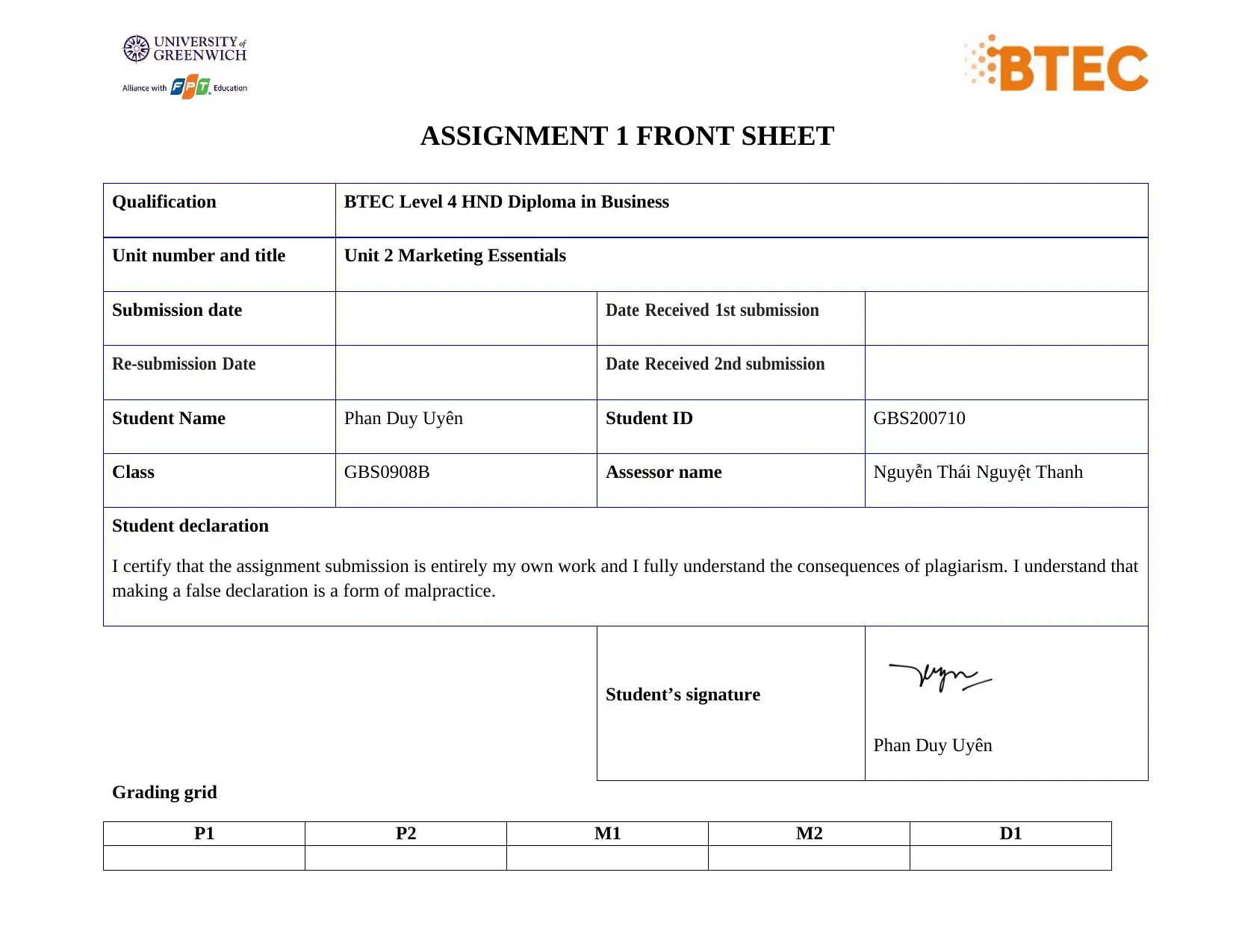
ASSIGNMENT 1 FRONT SHEET
Qualification BTEC Level 4 HND Diploma in Business
Unit number and title Unit 2 Marketing Essentials
Submission date Date Received 1st submission
Re-submission Date Date Received 2nd submission
Student Name Phan Duy Uyên Student ID GBS200710
Class GBS0908B Assessor name Nguyễn Thái Nguyệt Thanh
Student declaration
I certify that the assignment submission is entirely my own work and I fully understand the consequences of plagiarism. I understand that
making a false declaration is a form of malpractice.
Student’s signature
Phan Duy Uyên
Grading grid
P1 P2 M1 M2 D1
Qualification BTEC Level 4 HND Diploma in Business
Unit number and title Unit 2 Marketing Essentials
Submission date Date Received 1st submission
Re-submission Date Date Received 2nd submission
Student Name Phan Duy Uyên Student ID GBS200710
Class GBS0908B Assessor name Nguyễn Thái Nguyệt Thanh
Student declaration
I certify that the assignment submission is entirely my own work and I fully understand the consequences of plagiarism. I understand that
making a false declaration is a form of malpractice.
Student’s signature
Phan Duy Uyên
Grading grid
P1 P2 M1 M2 D1
Paraphrase This Document
Need a fresh take? Get an instant paraphrase of this document with our AI Paraphraser
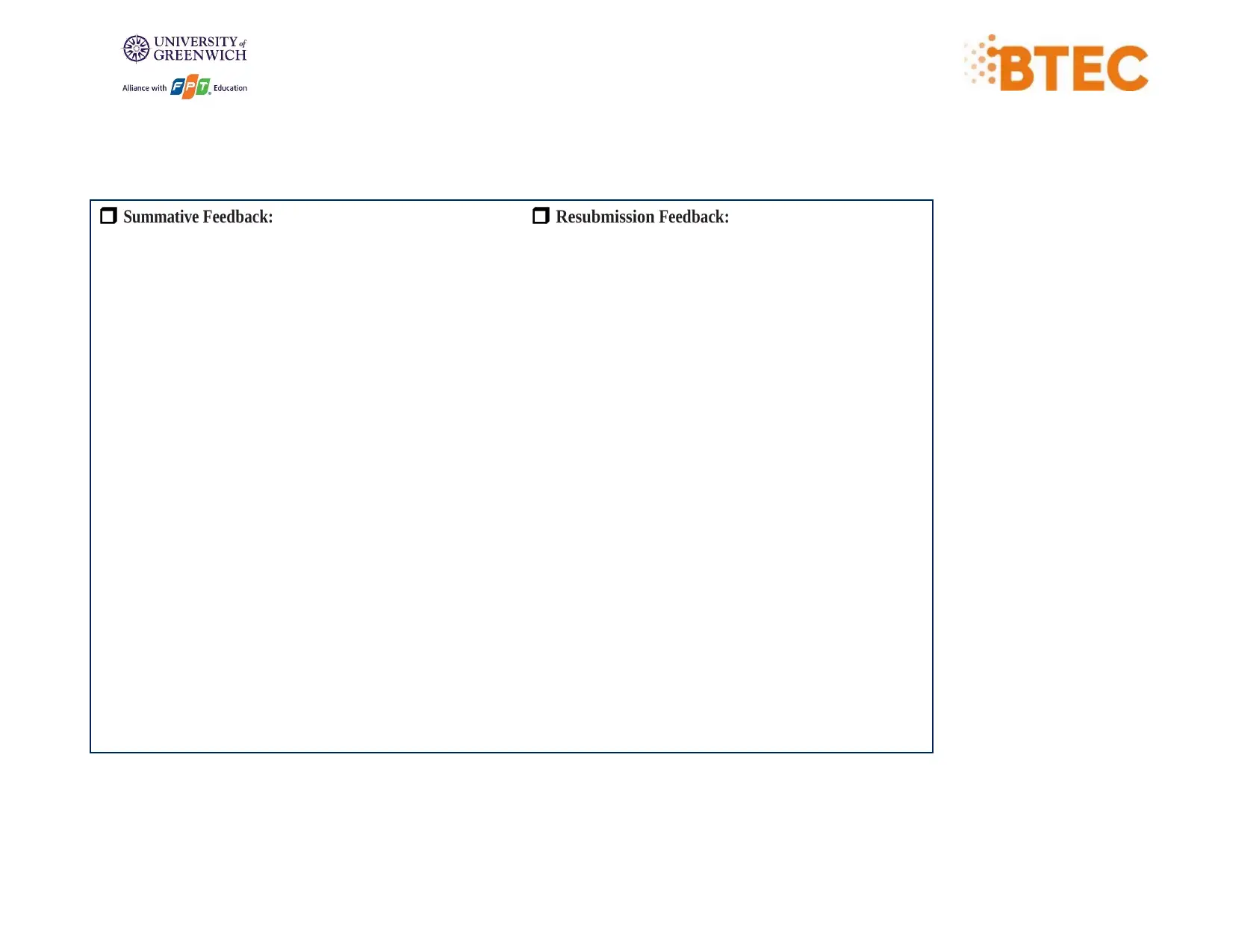
Summative Feedback: Resubmission Feedback:
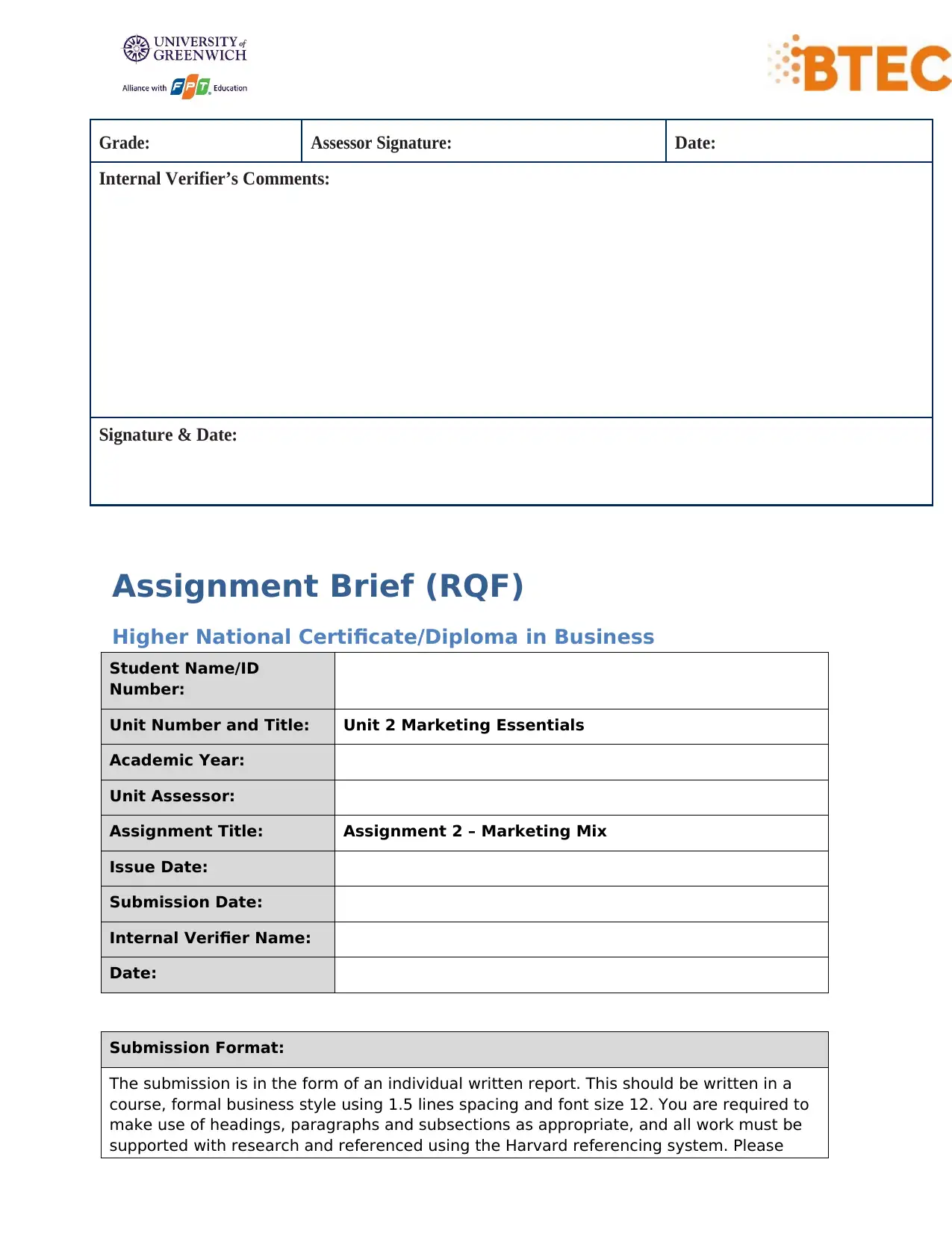
Grade: Assessor Signature: Date:
Internal Verifier’s Comments:
Signature & Date:
Assignment Brief (RQF)
Higher National Certificate/Diploma in Business
Student Name/ID
Number:
Unit Number and Title: Unit 2 Marketing Essentials
Academic Year:
Unit Assessor:
Assignment Title: Assignment 2 – Marketing Mix
Issue Date:
Submission Date:
Internal Verifier Name:
Date:
Submission Format:
The submission is in the form of an individual written report. This should be written in a
course, formal business style using 1.5 lines spacing and font size 12. You are required to
make use of headings, paragraphs and subsections as appropriate, and all work must be
supported with research and referenced using the Harvard referencing system. Please
Internal Verifier’s Comments:
Signature & Date:
Assignment Brief (RQF)
Higher National Certificate/Diploma in Business
Student Name/ID
Number:
Unit Number and Title: Unit 2 Marketing Essentials
Academic Year:
Unit Assessor:
Assignment Title: Assignment 2 – Marketing Mix
Issue Date:
Submission Date:
Internal Verifier Name:
Date:
Submission Format:
The submission is in the form of an individual written report. This should be written in a
course, formal business style using 1.5 lines spacing and font size 12. You are required to
make use of headings, paragraphs and subsections as appropriate, and all work must be
supported with research and referenced using the Harvard referencing system. Please
⊘ This is a preview!⊘
Do you want full access?
Subscribe today to unlock all pages.

Trusted by 1+ million students worldwide
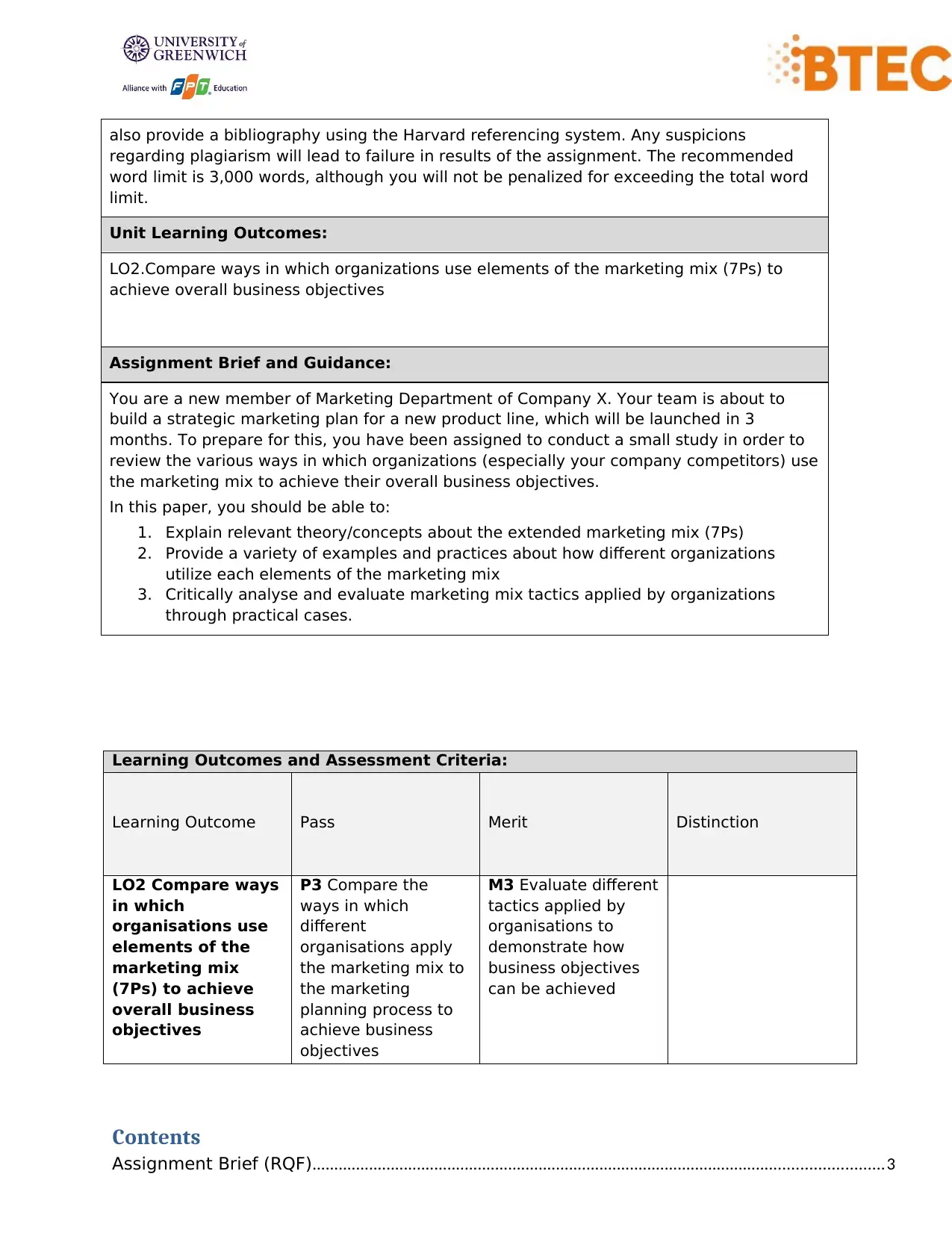
also provide a bibliography using the Harvard referencing system. Any suspicions
regarding plagiarism will lead to failure in results of the assignment. The recommended
word limit is 3,000 words, although you will not be penalized for exceeding the total word
limit.
Unit Learning Outcomes:
LO2.Compare ways in which organizations use elements of the marketing mix (7Ps) to
achieve overall business objectives
Assignment Brief and Guidance:
You are a new member of Marketing Department of Company X. Your team is about to
build a strategic marketing plan for a new product line, which will be launched in 3
months. To prepare for this, you have been assigned to conduct a small study in order to
review the various ways in which organizations (especially your company competitors) use
the marketing mix to achieve their overall business objectives.
In this paper, you should be able to:
1. Explain relevant theory/concepts about the extended marketing mix (7Ps)
2. Provide a variety of examples and practices about how different organizations
utilize each elements of the marketing mix
3. Critically analyse and evaluate marketing mix tactics applied by organizations
through practical cases.
Learning Outcomes and Assessment Criteria:
Learning Outcome Pass Merit Distinction
LO2 Compare ways
in which
organisations use
elements of the
marketing mix
(7Ps) to achieve
overall business
objectives
P3 Compare the
ways in which
different
organisations apply
the marketing mix to
the marketing
planning process to
achieve business
objectives
M3 Evaluate different
tactics applied by
organisations to
demonstrate how
business objectives
can be achieved
Contents
Assignment Brief (RQF)...................................................................................................................................3
regarding plagiarism will lead to failure in results of the assignment. The recommended
word limit is 3,000 words, although you will not be penalized for exceeding the total word
limit.
Unit Learning Outcomes:
LO2.Compare ways in which organizations use elements of the marketing mix (7Ps) to
achieve overall business objectives
Assignment Brief and Guidance:
You are a new member of Marketing Department of Company X. Your team is about to
build a strategic marketing plan for a new product line, which will be launched in 3
months. To prepare for this, you have been assigned to conduct a small study in order to
review the various ways in which organizations (especially your company competitors) use
the marketing mix to achieve their overall business objectives.
In this paper, you should be able to:
1. Explain relevant theory/concepts about the extended marketing mix (7Ps)
2. Provide a variety of examples and practices about how different organizations
utilize each elements of the marketing mix
3. Critically analyse and evaluate marketing mix tactics applied by organizations
through practical cases.
Learning Outcomes and Assessment Criteria:
Learning Outcome Pass Merit Distinction
LO2 Compare ways
in which
organisations use
elements of the
marketing mix
(7Ps) to achieve
overall business
objectives
P3 Compare the
ways in which
different
organisations apply
the marketing mix to
the marketing
planning process to
achieve business
objectives
M3 Evaluate different
tactics applied by
organisations to
demonstrate how
business objectives
can be achieved
Contents
Assignment Brief (RQF)...................................................................................................................................3
Paraphrase This Document
Need a fresh take? Get an instant paraphrase of this document with our AI Paraphraser
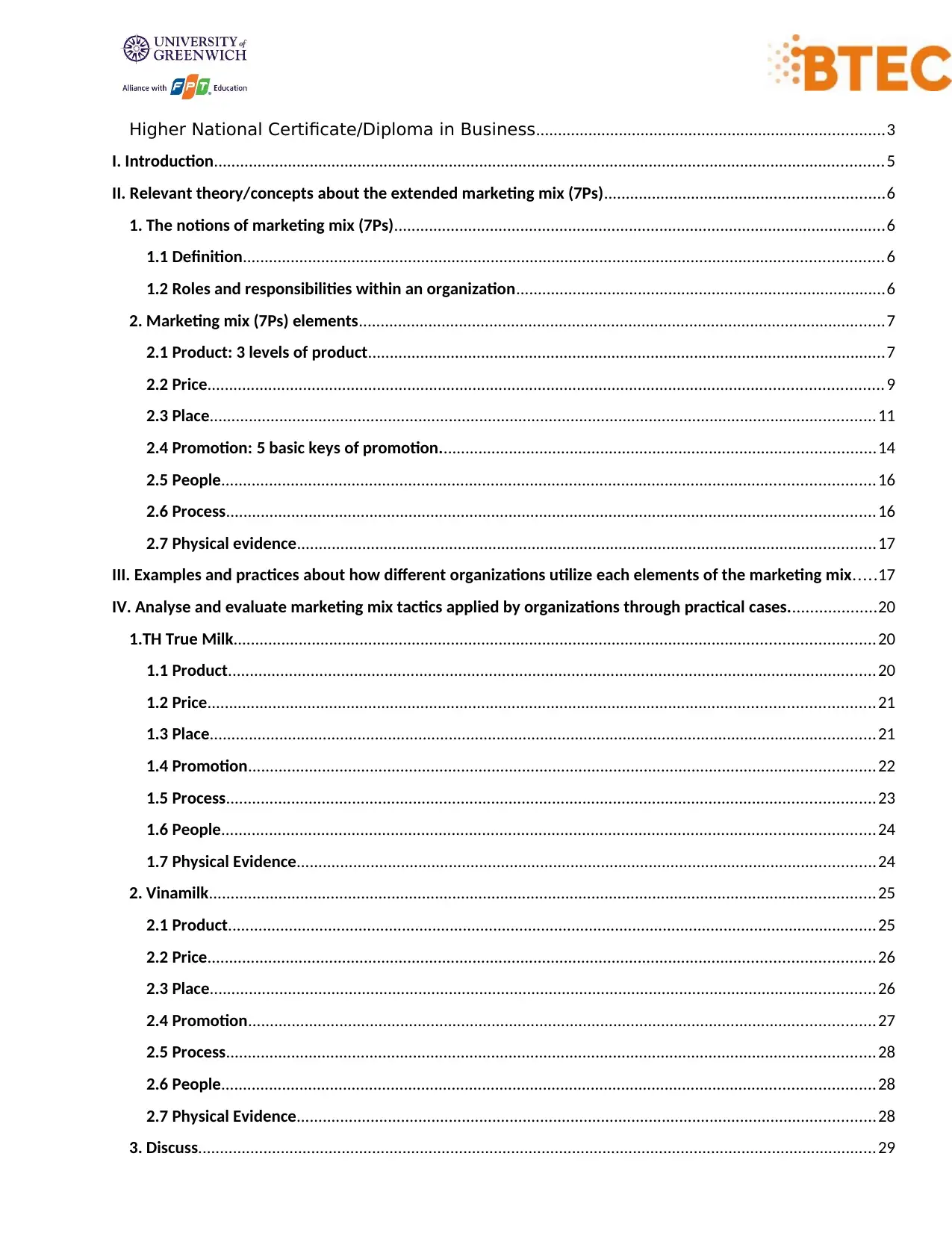
Higher National Certificate/Diploma in Business................................................................................3
I. Introduction..........................................................................................................................................................5
II. Relevant theory/concepts about the extended marketing mix (7Ps)................................................................6
1. The notions of marketing mix (7Ps).................................................................................................................6
1.1 Definition...................................................................................................................................................6
1.2 Roles and responsibilities within an organization.....................................................................................6
2. Marketing mix (7Ps) elements.........................................................................................................................7
2.1 Product: 3 levels of product.......................................................................................................................7
2.2 Price...........................................................................................................................................................9
2.3 Place.........................................................................................................................................................11
2.4 Promotion: 5 basic keys of promotion....................................................................................................14
2.5 People......................................................................................................................................................16
2.6 Process.....................................................................................................................................................16
2.7 Physical evidence.....................................................................................................................................17
III. Examples and practices about how different organizations utilize each elements of the marketing mix.....17
IV. Analyse and evaluate marketing mix tactics applied by organizations through practical cases....................20
1.TH True Milk...................................................................................................................................................20
1.1 Product.....................................................................................................................................................20
1.2 Price.........................................................................................................................................................21
1.3 Place.........................................................................................................................................................21
1.4 Promotion................................................................................................................................................22
1.5 Process.....................................................................................................................................................23
1.6 People......................................................................................................................................................24
1.7 Physical Evidence.....................................................................................................................................24
2. Vinamilk.........................................................................................................................................................25
2.1 Product.....................................................................................................................................................25
2.2 Price.........................................................................................................................................................26
2.3 Place.........................................................................................................................................................26
2.4 Promotion................................................................................................................................................27
2.5 Process.....................................................................................................................................................28
2.6 People......................................................................................................................................................28
2.7 Physical Evidence.....................................................................................................................................28
3. Discuss............................................................................................................................................................29
I. Introduction..........................................................................................................................................................5
II. Relevant theory/concepts about the extended marketing mix (7Ps)................................................................6
1. The notions of marketing mix (7Ps).................................................................................................................6
1.1 Definition...................................................................................................................................................6
1.2 Roles and responsibilities within an organization.....................................................................................6
2. Marketing mix (7Ps) elements.........................................................................................................................7
2.1 Product: 3 levels of product.......................................................................................................................7
2.2 Price...........................................................................................................................................................9
2.3 Place.........................................................................................................................................................11
2.4 Promotion: 5 basic keys of promotion....................................................................................................14
2.5 People......................................................................................................................................................16
2.6 Process.....................................................................................................................................................16
2.7 Physical evidence.....................................................................................................................................17
III. Examples and practices about how different organizations utilize each elements of the marketing mix.....17
IV. Analyse and evaluate marketing mix tactics applied by organizations through practical cases....................20
1.TH True Milk...................................................................................................................................................20
1.1 Product.....................................................................................................................................................20
1.2 Price.........................................................................................................................................................21
1.3 Place.........................................................................................................................................................21
1.4 Promotion................................................................................................................................................22
1.5 Process.....................................................................................................................................................23
1.6 People......................................................................................................................................................24
1.7 Physical Evidence.....................................................................................................................................24
2. Vinamilk.........................................................................................................................................................25
2.1 Product.....................................................................................................................................................25
2.2 Price.........................................................................................................................................................26
2.3 Place.........................................................................................................................................................26
2.4 Promotion................................................................................................................................................27
2.5 Process.....................................................................................................................................................28
2.6 People......................................................................................................................................................28
2.7 Physical Evidence.....................................................................................................................................28
3. Discuss............................................................................................................................................................29

V. Conclusion.........................................................................................................................................................30
VI. References........................................................................................................................................................30
I. Introduction
VI. References........................................................................................................................................................30
I. Introduction
⊘ This is a preview!⊘
Do you want full access?
Subscribe today to unlock all pages.

Trusted by 1+ million students worldwide
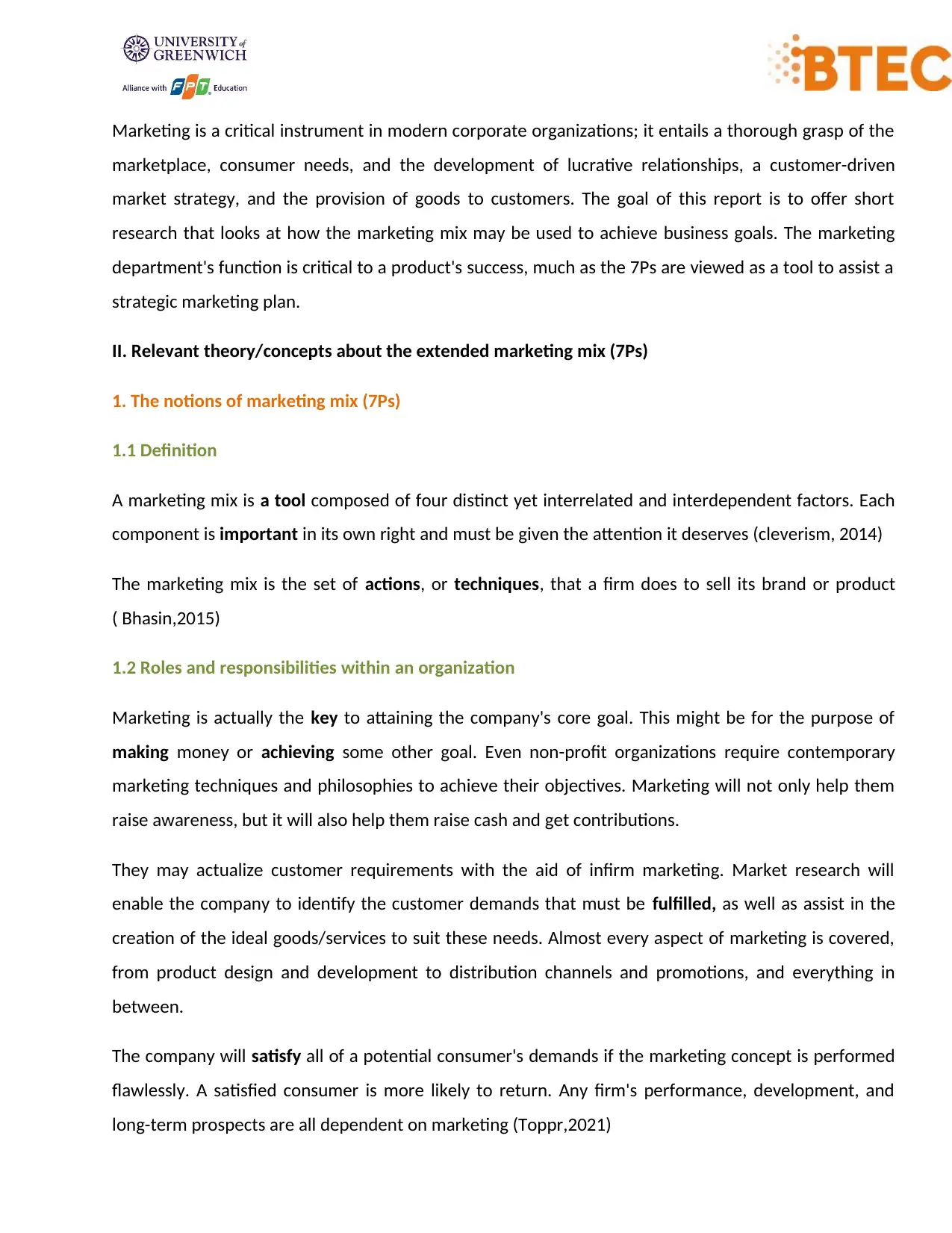
Marketing is a critical instrument in modern corporate organizations; it entails a thorough grasp of the
marketplace, consumer needs, and the development of lucrative relationships, a customer-driven
market strategy, and the provision of goods to customers. The goal of this report is to offer short
research that looks at how the marketing mix may be used to achieve business goals. The marketing
department's function is critical to a product's success, much as the 7Ps are viewed as a tool to assist a
strategic marketing plan.
II. Relevant theory/concepts about the extended marketing mix (7Ps)
1. The notions of marketing mix (7Ps)
1.1 Definition
A marketing mix is a tool composed of four distinct yet interrelated and interdependent factors. Each
component is important in its own right and must be given the attention it deserves (cleverism, 2014)
The marketing mix is the set of actions, or techniques, that a firm does to sell its brand or product
( Bhasin,2015)
1.2 Roles and responsibilities within an organization
Marketing is actually the key to attaining the company's core goal. This might be for the purpose of
making money or achieving some other goal. Even non-profit organizations require contemporary
marketing techniques and philosophies to achieve their objectives. Marketing will not only help them
raise awareness, but it will also help them raise cash and get contributions.
They may actualize customer requirements with the aid of infirm marketing. Market research will
enable the company to identify the customer demands that must be fulfilled, as well as assist in the
creation of the ideal goods/services to suit these needs. Almost every aspect of marketing is covered,
from product design and development to distribution channels and promotions, and everything in
between.
The company will satisfy all of a potential consumer's demands if the marketing concept is performed
flawlessly. A satisfied consumer is more likely to return. Any firm's performance, development, and
long-term prospects are all dependent on marketing (Toppr,2021)
marketplace, consumer needs, and the development of lucrative relationships, a customer-driven
market strategy, and the provision of goods to customers. The goal of this report is to offer short
research that looks at how the marketing mix may be used to achieve business goals. The marketing
department's function is critical to a product's success, much as the 7Ps are viewed as a tool to assist a
strategic marketing plan.
II. Relevant theory/concepts about the extended marketing mix (7Ps)
1. The notions of marketing mix (7Ps)
1.1 Definition
A marketing mix is a tool composed of four distinct yet interrelated and interdependent factors. Each
component is important in its own right and must be given the attention it deserves (cleverism, 2014)
The marketing mix is the set of actions, or techniques, that a firm does to sell its brand or product
( Bhasin,2015)
1.2 Roles and responsibilities within an organization
Marketing is actually the key to attaining the company's core goal. This might be for the purpose of
making money or achieving some other goal. Even non-profit organizations require contemporary
marketing techniques and philosophies to achieve their objectives. Marketing will not only help them
raise awareness, but it will also help them raise cash and get contributions.
They may actualize customer requirements with the aid of infirm marketing. Market research will
enable the company to identify the customer demands that must be fulfilled, as well as assist in the
creation of the ideal goods/services to suit these needs. Almost every aspect of marketing is covered,
from product design and development to distribution channels and promotions, and everything in
between.
The company will satisfy all of a potential consumer's demands if the marketing concept is performed
flawlessly. A satisfied consumer is more likely to return. Any firm's performance, development, and
long-term prospects are all dependent on marketing (Toppr,2021)
Paraphrase This Document
Need a fresh take? Get an instant paraphrase of this document with our AI Paraphraser
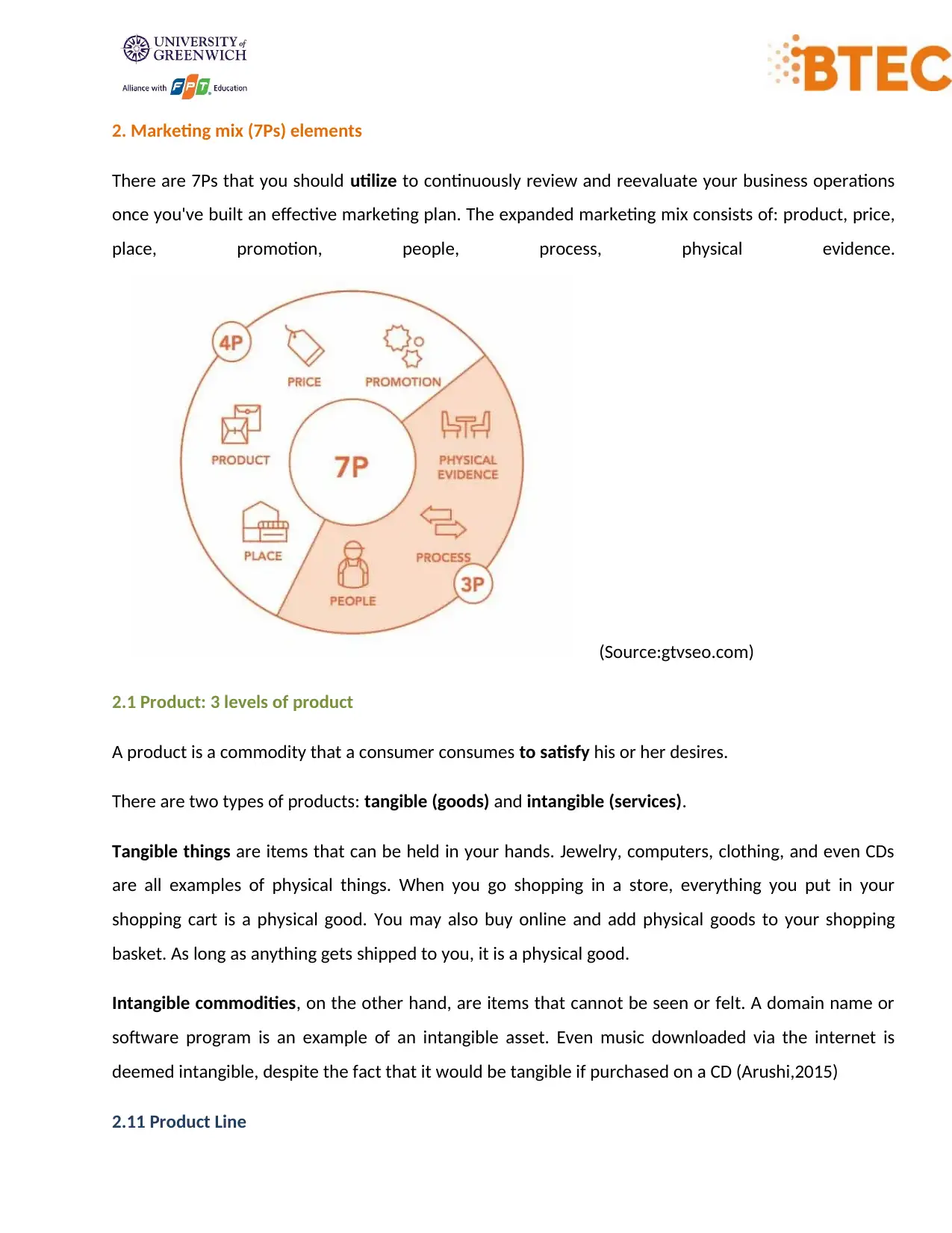
2. Marketing mix (7Ps) elements
There are 7Ps that you should utilize to continuously review and reevaluate your business operations
once you've built an effective marketing plan. The expanded marketing mix consists of: product, price,
place, promotion, people, process, physical evidence.
(Source:gtvseo.com)
2.1 Product: 3 levels of product
A product is a commodity that a consumer consumes to satisfy his or her desires.
There are two types of products: tangible (goods) and intangible (services).
Tangible things are items that can be held in your hands. Jewelry, computers, clothing, and even CDs
are all examples of physical things. When you go shopping in a store, everything you put in your
shopping cart is a physical good. You may also buy online and add physical goods to your shopping
basket. As long as anything gets shipped to you, it is a physical good.
Intangible commodities, on the other hand, are items that cannot be seen or felt. A domain name or
software program is an example of an intangible asset. Even music downloaded via the internet is
deemed intangible, despite the fact that it would be tangible if purchased on a CD (Arushi,2015)
2.11 Product Line
There are 7Ps that you should utilize to continuously review and reevaluate your business operations
once you've built an effective marketing plan. The expanded marketing mix consists of: product, price,
place, promotion, people, process, physical evidence.
(Source:gtvseo.com)
2.1 Product: 3 levels of product
A product is a commodity that a consumer consumes to satisfy his or her desires.
There are two types of products: tangible (goods) and intangible (services).
Tangible things are items that can be held in your hands. Jewelry, computers, clothing, and even CDs
are all examples of physical things. When you go shopping in a store, everything you put in your
shopping cart is a physical good. You may also buy online and add physical goods to your shopping
basket. As long as anything gets shipped to you, it is a physical good.
Intangible commodities, on the other hand, are items that cannot be seen or felt. A domain name or
software program is an example of an intangible asset. Even music downloaded via the internet is
deemed intangible, despite the fact that it would be tangible if purchased on a CD (Arushi,2015)
2.11 Product Line
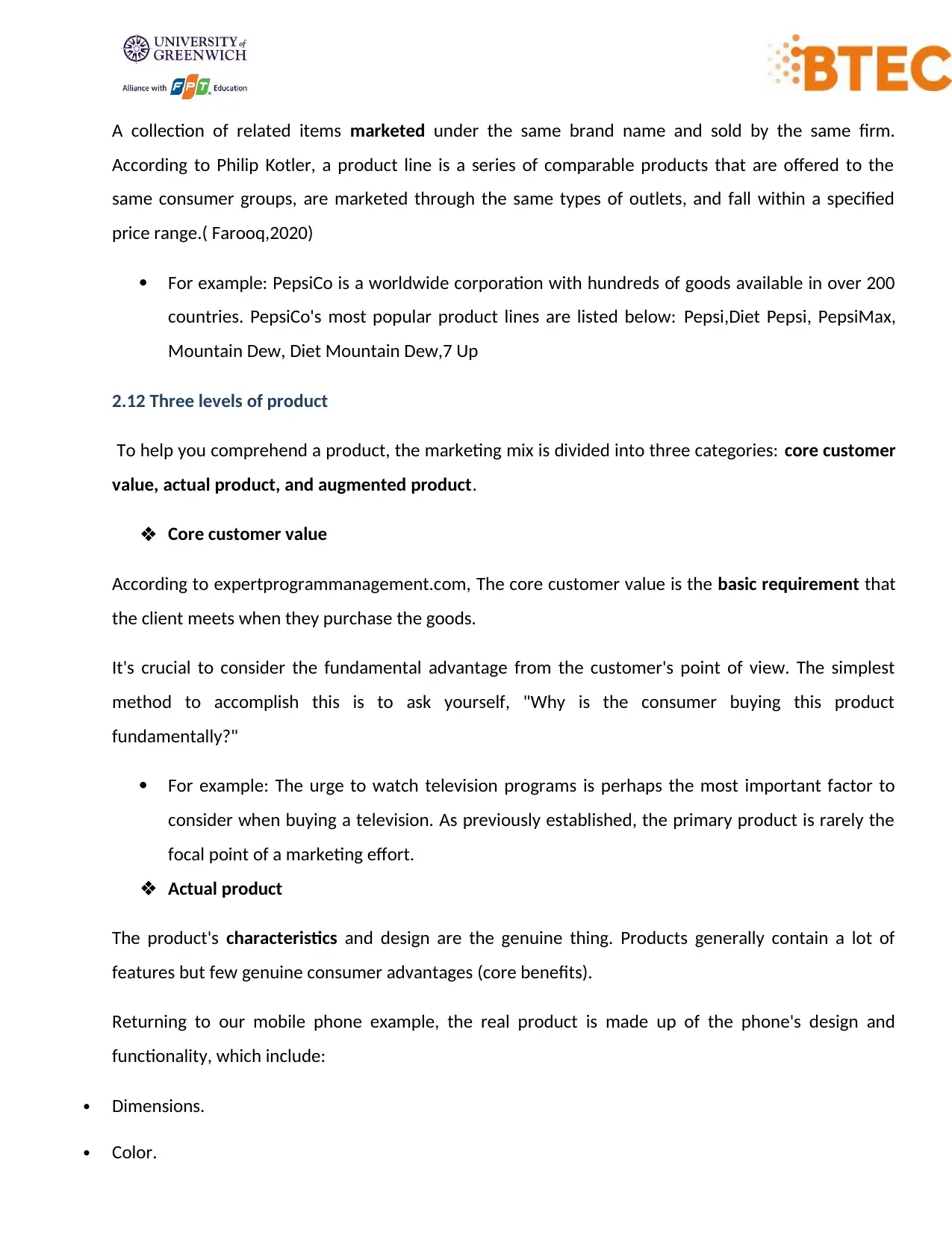
A collection of related items marketed under the same brand name and sold by the same firm.
According to Philip Kotler, a product line is a series of comparable products that are offered to the
same consumer groups, are marketed through the same types of outlets, and fall within a specified
price range.( Farooq,2020)
For example: PepsiCo is a worldwide corporation with hundreds of goods available in over 200
countries. PepsiCo's most popular product lines are listed below: Pepsi,Diet Pepsi, PepsiMax,
Mountain Dew, Diet Mountain Dew,7 Up
2.12 Three levels of product
To help you comprehend a product, the marketing mix is divided into three categories: core customer
value, actual product, and augmented product.
Core customer value
According to expertprogrammanagement.com, The core customer value is the basic requirement that
the client meets when they purchase the goods.
It's crucial to consider the fundamental advantage from the customer's point of view. The simplest
method to accomplish this is to ask yourself, "Why is the consumer buying this product
fundamentally?"
For example: The urge to watch television programs is perhaps the most important factor to
consider when buying a television. As previously established, the primary product is rarely the
focal point of a marketing effort.
Actual product
The product's characteristics and design are the genuine thing. Products generally contain a lot of
features but few genuine consumer advantages (core benefits).
Returning to our mobile phone example, the real product is made up of the phone's design and
functionality, which include:
Dimensions.
Color.
According to Philip Kotler, a product line is a series of comparable products that are offered to the
same consumer groups, are marketed through the same types of outlets, and fall within a specified
price range.( Farooq,2020)
For example: PepsiCo is a worldwide corporation with hundreds of goods available in over 200
countries. PepsiCo's most popular product lines are listed below: Pepsi,Diet Pepsi, PepsiMax,
Mountain Dew, Diet Mountain Dew,7 Up
2.12 Three levels of product
To help you comprehend a product, the marketing mix is divided into three categories: core customer
value, actual product, and augmented product.
Core customer value
According to expertprogrammanagement.com, The core customer value is the basic requirement that
the client meets when they purchase the goods.
It's crucial to consider the fundamental advantage from the customer's point of view. The simplest
method to accomplish this is to ask yourself, "Why is the consumer buying this product
fundamentally?"
For example: The urge to watch television programs is perhaps the most important factor to
consider when buying a television. As previously established, the primary product is rarely the
focal point of a marketing effort.
Actual product
The product's characteristics and design are the genuine thing. Products generally contain a lot of
features but few genuine consumer advantages (core benefits).
Returning to our mobile phone example, the real product is made up of the phone's design and
functionality, which include:
Dimensions.
Color.
⊘ This is a preview!⊘
Do you want full access?
Subscribe today to unlock all pages.

Trusted by 1+ million students worldwide
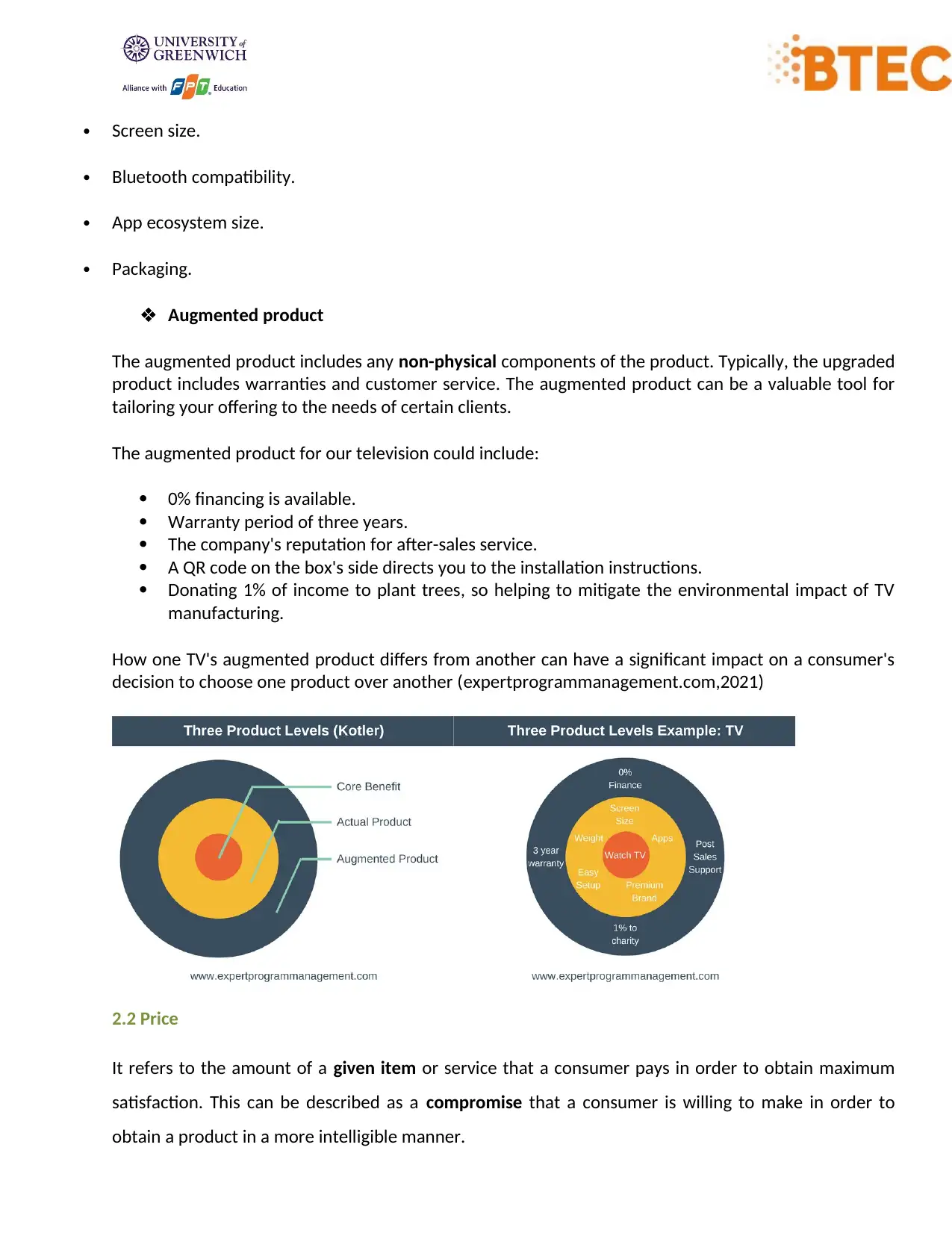
Screen size.
Bluetooth compatibility.
App ecosystem size.
Packaging.
Augmented product
The augmented product includes any non-physical components of the product. Typically, the upgraded
product includes warranties and customer service. The augmented product can be a valuable tool for
tailoring your offering to the needs of certain clients.
The augmented product for our television could include:
0% financing is available.
Warranty period of three years.
The company's reputation for after-sales service.
A QR code on the box's side directs you to the installation instructions.
Donating 1% of income to plant trees, so helping to mitigate the environmental impact of TV
manufacturing.
How one TV's augmented product differs from another can have a significant impact on a consumer's
decision to choose one product over another (expertprogrammanagement.com,2021)
2.2 Price
It refers to the amount of a given item or service that a consumer pays in order to obtain maximum
satisfaction. This can be described as a compromise that a consumer is willing to make in order to
obtain a product in a more intelligible manner.
Bluetooth compatibility.
App ecosystem size.
Packaging.
Augmented product
The augmented product includes any non-physical components of the product. Typically, the upgraded
product includes warranties and customer service. The augmented product can be a valuable tool for
tailoring your offering to the needs of certain clients.
The augmented product for our television could include:
0% financing is available.
Warranty period of three years.
The company's reputation for after-sales service.
A QR code on the box's side directs you to the installation instructions.
Donating 1% of income to plant trees, so helping to mitigate the environmental impact of TV
manufacturing.
How one TV's augmented product differs from another can have a significant impact on a consumer's
decision to choose one product over another (expertprogrammanagement.com,2021)
2.2 Price
It refers to the amount of a given item or service that a consumer pays in order to obtain maximum
satisfaction. This can be described as a compromise that a consumer is willing to make in order to
obtain a product in a more intelligible manner.
Paraphrase This Document
Need a fresh take? Get an instant paraphrase of this document with our AI Paraphraser
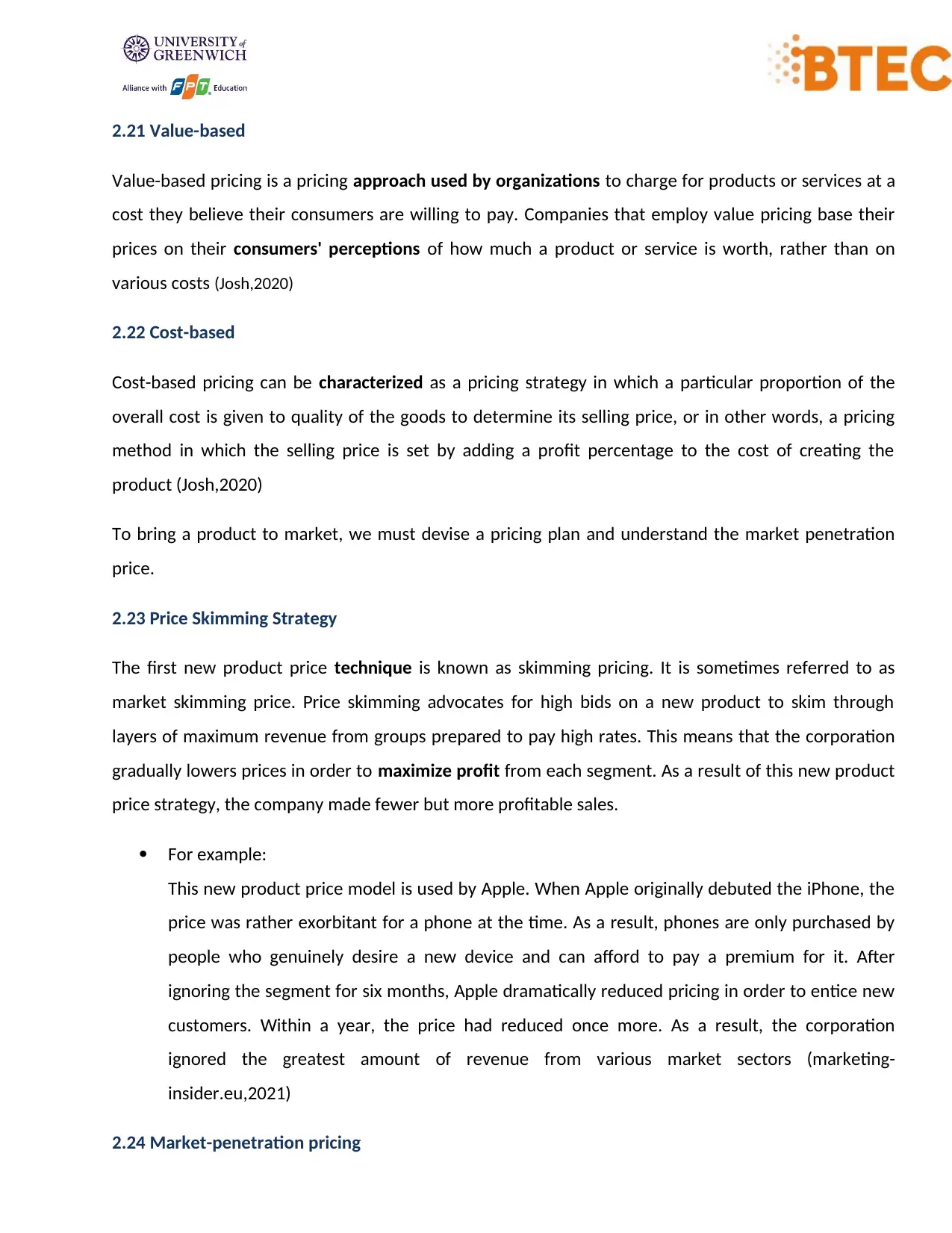
2.21 Value-based
Value-based pricing is a pricing approach used by organizations to charge for products or services at a
cost they believe their consumers are willing to pay. Companies that employ value pricing base their
prices on their consumers' perceptions of how much a product or service is worth, rather than on
various costs (Josh,2020)
2.22 Cost-based
Cost-based pricing can be characterized as a pricing strategy in which a particular proportion of the
overall cost is given to quality of the goods to determine its selling price, or in other words, a pricing
method in which the selling price is set by adding a profit percentage to the cost of creating the
product (Josh,2020)
To bring a product to market, we must devise a pricing plan and understand the market penetration
price.
2.23 Price Skimming Strategy
The first new product price technique is known as skimming pricing. It is sometimes referred to as
market skimming price. Price skimming advocates for high bids on a new product to skim through
layers of maximum revenue from groups prepared to pay high rates. This means that the corporation
gradually lowers prices in order to maximize profit from each segment. As a result of this new product
price strategy, the company made fewer but more profitable sales.
For example:
This new product price model is used by Apple. When Apple originally debuted the iPhone, the
price was rather exorbitant for a phone at the time. As a result, phones are only purchased by
people who genuinely desire a new device and can afford to pay a premium for it. After
ignoring the segment for six months, Apple dramatically reduced pricing in order to entice new
customers. Within a year, the price had reduced once more. As a result, the corporation
ignored the greatest amount of revenue from various market sectors (marketing-
insider.eu,2021)
2.24 Market-penetration pricing
Value-based pricing is a pricing approach used by organizations to charge for products or services at a
cost they believe their consumers are willing to pay. Companies that employ value pricing base their
prices on their consumers' perceptions of how much a product or service is worth, rather than on
various costs (Josh,2020)
2.22 Cost-based
Cost-based pricing can be characterized as a pricing strategy in which a particular proportion of the
overall cost is given to quality of the goods to determine its selling price, or in other words, a pricing
method in which the selling price is set by adding a profit percentage to the cost of creating the
product (Josh,2020)
To bring a product to market, we must devise a pricing plan and understand the market penetration
price.
2.23 Price Skimming Strategy
The first new product price technique is known as skimming pricing. It is sometimes referred to as
market skimming price. Price skimming advocates for high bids on a new product to skim through
layers of maximum revenue from groups prepared to pay high rates. This means that the corporation
gradually lowers prices in order to maximize profit from each segment. As a result of this new product
price strategy, the company made fewer but more profitable sales.
For example:
This new product price model is used by Apple. When Apple originally debuted the iPhone, the
price was rather exorbitant for a phone at the time. As a result, phones are only purchased by
people who genuinely desire a new device and can afford to pay a premium for it. After
ignoring the segment for six months, Apple dramatically reduced pricing in order to entice new
customers. Within a year, the price had reduced once more. As a result, the corporation
ignored the greatest amount of revenue from various market sectors (marketing-
insider.eu,2021)
2.24 Market-penetration pricing
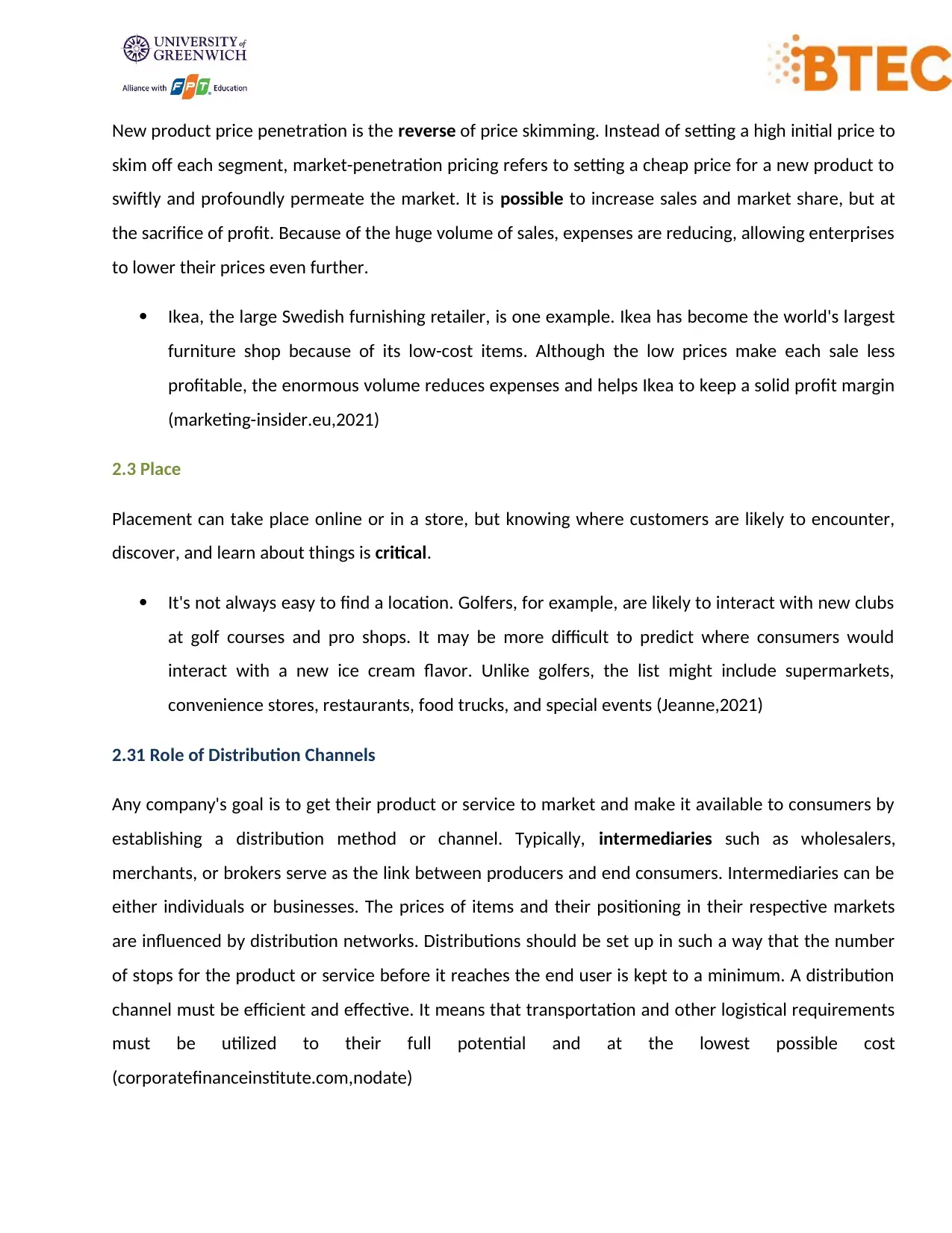
New product price penetration is the reverse of price skimming. Instead of setting a high initial price to
skim off each segment, market-penetration pricing refers to setting a cheap price for a new product to
swiftly and profoundly permeate the market. It is possible to increase sales and market share, but at
the sacrifice of profit. Because of the huge volume of sales, expenses are reducing, allowing enterprises
to lower their prices even further.
Ikea, the large Swedish furnishing retailer, is one example. Ikea has become the world's largest
furniture shop because of its low-cost items. Although the low prices make each sale less
profitable, the enormous volume reduces expenses and helps Ikea to keep a solid profit margin
(marketing-insider.eu,2021)
2.3 Place
Placement can take place online or in a store, but knowing where customers are likely to encounter,
discover, and learn about things is critical.
It's not always easy to find a location. Golfers, for example, are likely to interact with new clubs
at golf courses and pro shops. It may be more difficult to predict where consumers would
interact with a new ice cream flavor. Unlike golfers, the list might include supermarkets,
convenience stores, restaurants, food trucks, and special events (Jeanne,2021)
2.31 Role of Distribution Channels
Any company's goal is to get their product or service to market and make it available to consumers by
establishing a distribution method or channel. Typically, intermediaries such as wholesalers,
merchants, or brokers serve as the link between producers and end consumers. Intermediaries can be
either individuals or businesses. The prices of items and their positioning in their respective markets
are influenced by distribution networks. Distributions should be set up in such a way that the number
of stops for the product or service before it reaches the end user is kept to a minimum. A distribution
channel must be efficient and effective. It means that transportation and other logistical requirements
must be utilized to their full potential and at the lowest possible cost
(corporatefinanceinstitute.com,nodate)
skim off each segment, market-penetration pricing refers to setting a cheap price for a new product to
swiftly and profoundly permeate the market. It is possible to increase sales and market share, but at
the sacrifice of profit. Because of the huge volume of sales, expenses are reducing, allowing enterprises
to lower their prices even further.
Ikea, the large Swedish furnishing retailer, is one example. Ikea has become the world's largest
furniture shop because of its low-cost items. Although the low prices make each sale less
profitable, the enormous volume reduces expenses and helps Ikea to keep a solid profit margin
(marketing-insider.eu,2021)
2.3 Place
Placement can take place online or in a store, but knowing where customers are likely to encounter,
discover, and learn about things is critical.
It's not always easy to find a location. Golfers, for example, are likely to interact with new clubs
at golf courses and pro shops. It may be more difficult to predict where consumers would
interact with a new ice cream flavor. Unlike golfers, the list might include supermarkets,
convenience stores, restaurants, food trucks, and special events (Jeanne,2021)
2.31 Role of Distribution Channels
Any company's goal is to get their product or service to market and make it available to consumers by
establishing a distribution method or channel. Typically, intermediaries such as wholesalers,
merchants, or brokers serve as the link between producers and end consumers. Intermediaries can be
either individuals or businesses. The prices of items and their positioning in their respective markets
are influenced by distribution networks. Distributions should be set up in such a way that the number
of stops for the product or service before it reaches the end user is kept to a minimum. A distribution
channel must be efficient and effective. It means that transportation and other logistical requirements
must be utilized to their full potential and at the lowest possible cost
(corporatefinanceinstitute.com,nodate)
⊘ This is a preview!⊘
Do you want full access?
Subscribe today to unlock all pages.

Trusted by 1+ million students worldwide
1 out of 33
Related Documents
Your All-in-One AI-Powered Toolkit for Academic Success.
+13062052269
info@desklib.com
Available 24*7 on WhatsApp / Email
![[object Object]](/_next/static/media/star-bottom.7253800d.svg)
Unlock your academic potential
Copyright © 2020–2025 A2Z Services. All Rights Reserved. Developed and managed by ZUCOL.





